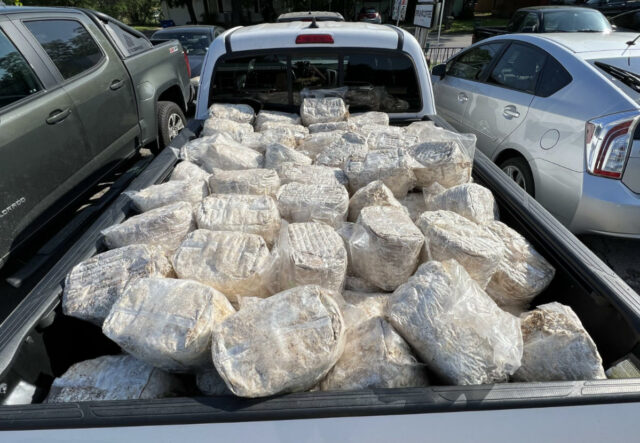A version of this article originally appeared in The Deep Dish, our members-only newsletter. Become a member today and get the next issue directly in your inbox.
Collar City Mushrooms occupies a small building along the post-industrial waterfront of Troy, New York. Out back, baking in the winter sun between a shed and a yellow Volkswagen bus, sits a waist-high heap of what looks like dozens of giant Frosted Mini-Wheats, each roughly the size of a cinder block. The weathered caps of oyster mushrooms sprout defiantly from various points in the pile.
The lumpy blocks are spent substrate, the living material left over after growing mushrooms. Composed of sawdust and soy pellets woven through with mycelium—the thread-like aspect of the fungus from which mushrooms sprout—spent substrate is a unique kind of waste. It’s also one with many potential uses; it can be used as compost, as a means of decontaminating soil, as biofuel, and simply for growing more mushrooms. And while each of those uses could provide revenue potential for mushroom farms, the expanding piles of spent substrate also represent a mounting logistical challenge.
“If you’re gonna do it, awesome, but account for this waste stream you’re producing and how you’re gonna get it off of your property.”
“Right now, we have people picking it up almost as a favor for us, because otherwise what are we doing with it?” said Avery Stempel, Collar City’s co-founder, as we gazed upon the pile. Stempel currently takes most of the material to a nearby compost facility, but local farms, gardeners, and florists also take a portion. So do individuals, whether for compost in their gardens or just to grow mushrooms at home. “People will come and buy a bucket for five bucks,” Stempel said.
Before it’s put to work growing mushrooms, substrate is carefully mixed and sterilized to maximize efficiency and prevent competition for the fungus. Protected inside breathable plastic bags, the sawdust and soy hulls are inoculated with an edible mushroom strain, then stacked on racks in climate-controlled rooms. The bags are sliced open when the mycelium is ready, and out sprouts the first “flush” of mushrooms. To make the best use of space, many farms will dispose of the blocks after a single flush, but each block is capable of several rounds of mushroom production. In this sense, the substrate isn’t really “spent.”
Spent substrate waiting to be collected and reused. (Photo courtesy of Central Texas Mycological Society)
Collar City is a relatively small operation, producing up to 1,000 pounds of mushrooms a week. An hour south, in Hillsdale, New York, Tivoli Mushrooms produces around 20,000 pounds per week, and it’s currently only using half the capacity of its new 15,000-square-foot facility. Soon after moving in, Co-founder Devon Gilroy reached out to a neighboring organic farm, offering the spent substrate for free as compost if they would simply take it off his hands. It wasn’t a tough sell. “They showed up like two weeks later with a tractor and a big truck to load it in,” he said. “They insisted on paying us for the substrate, which really helped.”
More Mushrooms, More Problems
From a revenue perspective, specialty mushroom substrate’s greatest value is currently as compost, which can sell for around $150 per cubic yard. It has a low pH level, useful in soils with low acidity, and a carbon-to-nitrogen ratio of roughly 40 to 1, which is close to ideal for building healthy soil. Spent substrate is also a useful addition to vermicompost—worms love to eat mycelium, and in doing, so they also break down woody debris and support soil biodiversity. It is also an excellent addition for structure and water retention.
But that doesn’t mean every mushroom farm has an easy time finding a second life for its spent substrate, and the quandary of how to make use of the material is growing along with the scale of the specialty mushroom industry.
“If you’re gonna do it, awesome, but account for this waste stream you’re producing and how you’re gonna get it off of your property.” That’s the advice Amanda Janney, founder of KM Mushrooms in California, offers new farmers. Janney’s farm is about as modest as they come, operating out of her home in Santa Rosa. As the farm’s output quickly grew, from 20 pounds of mushrooms a week to around 300, the leftover material quickly became a logistical problem to be solved.
“In the beginning when we were doing really low volume, it was not much of a consideration; giving bags of spent substrate out via Craigslist and Facebook Marketplace was sufficient,” said Janney. “Then production increased a lot faster than I had planned on, which is a great thing, but a big piece of it became connecting with farmers that were interested in [taking substrate] and getting a workflow to move it off the property quickly.”
In 2022, driven in large part by consumer interest in meat alternatives, global revenues for mushrooms were predicted to more than double to over $110 billion by 2030. The nutraceutical market for medicinal mushrooms—such as reishi, lion’s mane, and cordyceps—may follow a similar trajectory, with one forecast suggesting the market could triple to reach $62 billion by 2032.
The vast majority—95 percent—of the mushroom production in the U.S. is in Agaricus: the common cremini, button, or portobello (all the same species). Every other variety, be it shiitake or oyster, falls in the specialty mushroom category.





